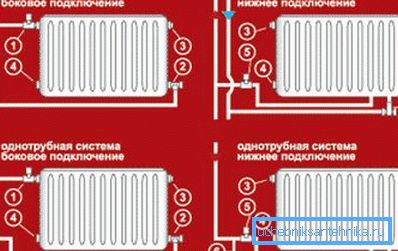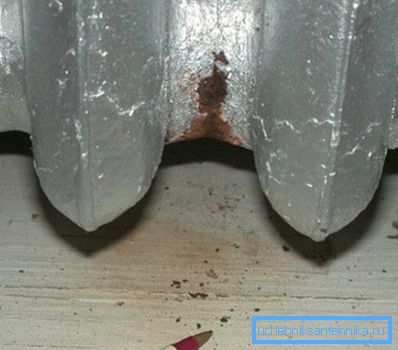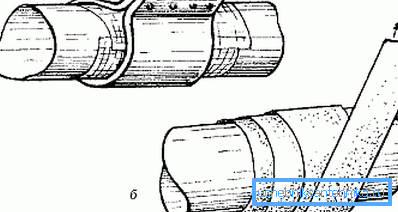Independent heating repair: is it possible?
In most cases, the repair of heating systems is in the cast-iron radiators, which are already old and rusted at the bottom of the sections. But there are also leaks and even pipe breaks, which have to be changed partially or completely.
If we are going to talk about repair work, then we will focus our attention on apartments from multi-storey buildings of the Stalisko-Khrushchev-Brezhnev period, where the systems have long been time to change. Therefore, we delimit in two directions - the tubes and the heaters themselves, and in addition, we will show you a themed video clip.

Old heating systems

- First of all, it should be noted that heating systems can be both single-pipe and double-pipe, which fundamentally changes the principle of heat transfer to the radiators and its distribution.
- The dual-circuit system works as follows - hot water is supplied from the CHP plant, the central boiler house or the distribution point (TP) through one pipe, from which the coolant flows into the batteries. After circulation through the sections, the water is discharged into another pipe and returns back to the heating unit. The advantage of such a system is that all the liquid entering the radiators remains at the same temperature throughout the whole circuit.
- A completely different picture in a single-circuit system - hot water, entering the radiator and passing a cycle of all sections, goes back into the same pipe, therefore, the greater the serial number of the heater, the colder the coolant will be. By and large, the instruction indicates that a maximum of three or four first points remain without heat losses.

- A slight relief for maintaining the supply temperature in single-pipe systems is the bypass through which some of the hot water passes, but this is only theoretically. The fact is that the residents, feeling the lack of heat in the devices, cut a stopcock into the bypass and all the liquid starts to circulate through the radiator, making it part of the supply circuit. But again, this only makes it better for the upper or lower floors (depending on the supply (upper or lower)), but for those whose radiators are farther away, it gets even worse.
Note. In addition, cold radiators in the apartment may be due to air congestion or clogging of the system. But if you can remove the traffic jams yourself by bleeding air at the end points and radiators, then the system should be cleaned with utilities. You can safely demand this service from them (but not during the heating season), as it is charged to them.
Radiators

Radiator leakage, as a rule, can occur in two places - these are the joints of the sections, as in the photo above, or their lower part. In the first case, the cause of the leak is gasket or nipple wear, which can be replaced, and in the second case, metal corrosion from the inside.

It is quite possible to repair heaters in such situations, but again not during the heating season, as the shut-off valves (taps) are not provided for by the project and can only be there if you cut them yourself.
Whatever it was, but the radiator needs to be removed and disassembled into sections, more precisely, in the place where the leakage was found and if it is a joint, then you just have to replace the nipple or gasket, and then assemble the battery back and put it in place.
It is much worse when the sections are out of order due to metal corrosion - ideally you just need to remove such a section and replace it with a new one, but here it’s not always so simple. The fact is that in the old radiators during the repair a new leak may open and if there is corrosion on one section, then it will most likely be on the other.
It happens that plumbers remove the battery, change or simply remove the leaky section and after installing the heater back it begins to flow in a completely different place. It is best to change cast iron to bimetal - although the price of such heaters is higher, but the operational resource is much greater.
Council In cases where the radiator sections are leaky, it is better to replace it with a new one, and if this is not possible, remove the paint from the leak and seal it with dry welding or sealant, fitting the bandage of a bandage or rag in any way over this then you can remove it. Such a measure will allow you to wait for the end of the heating season.
Pipes

The easiest way to eliminate a leak in a pipe during the heating season is to apply a rubber bandage. To do this, you can use a harness, or cut off a strip from the old bicycle chamber, tightly wind it over the damaged place, and then clamp it with a yoke or just pieces of wire. Also under the bandage can be applied dry welding or sealant, which significantly
Of course, if the pipe gave a leak, then at the end of the heating season, such a section should be replaced by inserting a new piece. But sometimes welding work in the apartment is extremely undesirable, for example, because of a fresh repair or good wallpaper, so this replacement can be made on polypropylene. From two sides, a steel pipe is cut into a steel pipe and using a male threaded fitting on one side and an American woman on the other, solder a piece of IDB.
Conclusion
If you live in an old house and the heating starts to leak, then the best way out is not to repair it, but to replace it completely in a single apartment. Best of all, with your own hands or with the help of an outside specialist, remove the entire heating circuit and radiators, in order to replace steel pipes with polypropylene, and cast iron batteries - with steel or bimetal.